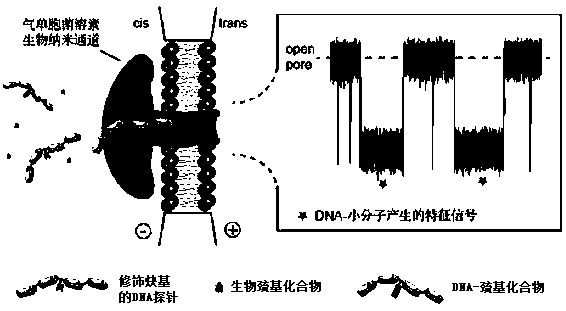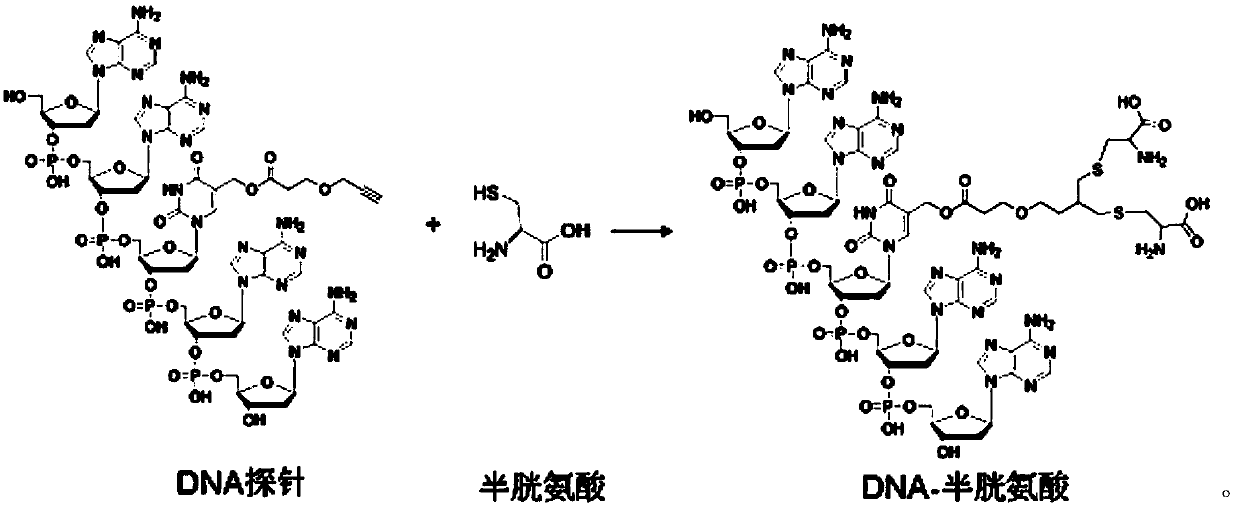A method for the detection of biothiol compounds based on aerolysin nanochannels
A technology for aerolysin and sulfhydryl compounds, which is applied in the field of detecting biological sulfhydryl compounds based on aeromonasin nanochannels, can solve problems such as difficulty in simultaneous detection, and achieves low price, active clinical treatment, and convenient operation. Effect
- Summary
- Abstract
- Description
- Claims
- Application Information
AI Technical Summary
Problems solved by technology
Method used
Image
Examples
Embodiment 1
[0043] A method for detecting biological thiol compounds based on aerolysin nanochannels for detecting cysteine, comprising the following steps:
[0044] (1) Design a DNA probe connected with an alkynyl group; the base length of the DNA probe is 4; the alkynyl group is modified in the middle position of four base nucleotides, which can be combined with the mercapto group of the mercapto compound Carry out addition reaction, finally form DNA probe-sulfhydryl compound adduct:
[0045]
[0046] (2) Mix 20 μL, 200 μM, pH value of 8.0 DNA probe solution with 10 μL, 1 mM, pH value of 8.0 cysteine solution, and irradiate with 320-400 nm ultraviolet light for 1-4 hours. The addition reaction of the alkyne group to the sulfhydryl group on the cysteine links the cysteine to the DNA probe.
[0047] (3) Preparation of aerolysin bionanochannels
[0048] ① Activated aerolysin
[0049]Dissolve aerolysin in trypsin-EDTA solution, place it in an incubator at 25°C for 30 minutes for...
Embodiment 2
[0068] A method for detecting biosulfhydryl compounds based on aerolysin nanochannels is used for detecting homocysteine, and the basic steps are the same as those in Example 1.
[0069] The difference is:
[0070] (1) (with embodiment 1).
[0071] (2) Mix 20 μL, 200 μM, pH value of 8.0 DNA probe solution with 10 μL, 5 mM, pH value of 8.0 homocysteine solution, and irradiate with 365 nm ultraviolet light for 2 hours. The addition reaction of the sulfhydryl group on homocysteine attaches homocysteine to the DNA probe.
[0072] (3) (with embodiment 1).
[0073] (4) Detection of DNA-homocysteine with aerolysin
[0074] Acquisition of DNA probe-homocysteine single-molecule characteristic signal-this signal is a single-molecule signal that can reflect the characteristics of homocysteine.
[0075] Example 2 Obtaining the characteristic blocking current of DNA probe-homocysteine single molecule is I / I 0 =0.30-0.35; where, I 0 is the opening current value; I is the b...
Embodiment 3
[0077] A method for detecting biosulfhydryl compounds based on the aerolysin nanochannel is used for detecting glutathione, and the basic steps are the same as those in Example 1.
[0078] The difference is:
[0079] (1) (with embodiment 1).
[0080] (2) Mix 20 μL, 200 μM, pH 8.0 DNA probe solution with 10 μL, 5 mM, pH 8.0 glutathione solution, and irradiate with 365 nm ultraviolet light for 2 hours to utilize the alkynyl and glutathione groups on the probe to The addition reaction of the sulfhydryl group on the glutathione links the glutathione to the DNA probe.
[0081] (3) (with embodiment 1).
[0082] (4) Detection of DNA probe-glutathione with aerolysin
[0083] Acquisition of DNA probe-glutathione single-molecule signature signal—this signal is a single-molecule signal that can reflect the signature of glutathione.
[0084] Example 3 obtains the characteristic blocking current of DNA probe-glutathione single molecule as I / I 0 =0.20~0.30; Among them, I 0 is the open...
PUM
 Login to View More
Login to View More Abstract
Description
Claims
Application Information
 Login to View More
Login to View More - R&D
- Intellectual Property
- Life Sciences
- Materials
- Tech Scout
- Unparalleled Data Quality
- Higher Quality Content
- 60% Fewer Hallucinations
Browse by: Latest US Patents, China's latest patents, Technical Efficacy Thesaurus, Application Domain, Technology Topic, Popular Technical Reports.
© 2025 PatSnap. All rights reserved.Legal|Privacy policy|Modern Slavery Act Transparency Statement|Sitemap|About US| Contact US: help@patsnap.com


